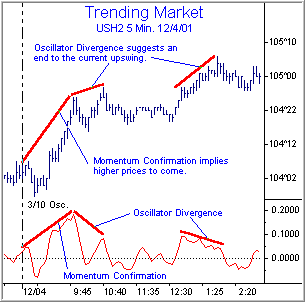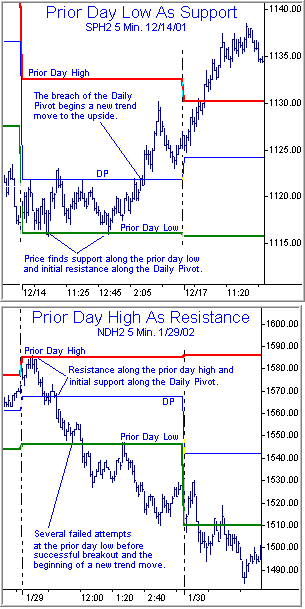
HOT TOPICS LIST
- MACD
- Fibonacci
- RSI
- Gann
- ADXR
- Stochastics
- Volume
- Triangles
- Futures
- Cycles
- Volatility
- ZIGZAG
- MESA
- Retracement
- Aroon
INDICATORS LIST
LIST OF TOPICS
PRINT THIS ARTICLE
by Bob Hunt
Each of the intraday trading techniques discussed in Parts 1 through 3 have relied on reference levels arrived at by means of mathematical calculations. In contrast, the technique discussed in this section will deal with a set of support and resistance levels that are much more intuitively obvious. In short, I will discuss a technique for using the prior day's price extremes as a means of determining market-based valuation levels.
Position: N/A
Bob Hunt
Creator of the Pattern Trapper On-Line Trading Course and editor of The Pattern Trapper Commodities Newsletter.
PRINT THIS ARTICLE
DAY TRADING
Technical Tools For Day Traders, Part 4: The Use of Prior Day Highs and Lows
06/13/02 01:42:08 PMby Bob Hunt
Each of the intraday trading techniques discussed in Parts 1 through 3 have relied on reference levels arrived at by means of mathematical calculations. In contrast, the technique discussed in this section will deal with a set of support and resistance levels that are much more intuitively obvious. In short, I will discuss a technique for using the prior day's price extremes as a means of determining market-based valuation levels.
Position: N/A
| If market activity is thought of as an auction process, where bidders and sellers are constantly vying for the best price, then daily time frame highs and lows represent the outer extremes of accepted value for any particular trading day. The highest price achieved during the day represents the maximum price that buyers were willing to offer for the commodity, and the lowest, the minimum sellers were willing to accept. For this reason, subsequent price action has a tendency to remain within the boundaries of apparent value as defined during the previous day of trading. |
| Under typical market conditions (news-driven price thrusts being one notable exception) a successful breach of a prior day's high or low is normally preceded by several failed attempts. Once achieved, such price action often represents an important shift in market psychology with the potential to create a new trend. |

|
| Figure 1: USH2 5-minute chart. |
| Graphic provided by: TradeStation. |
| |
| One approach for taking advantage of this market scenario is to use the actual break of the prior day's high or the prior day's low as the trigger into the trade-- going long on a break of the high, and short on the break of the low. Using such a method for market entry is certainly viable, and in fast market conditions may be the ONLY way of participating. However, it is considered to be a rather aggressive technique. Forays into new areas of market valuation are sometimes rejected in very quick fashion. A more conservative and risk averse approach is to delay entry until some sort of price retracement can occur. Such short-term pullbacks often take place before a new trend can begin in earnest. Many times, a breach of the prior day's high or low will retrace all the way back to the original breakout point. If not, the next most likely level of retracement will be that of the 5-minute 20EMA. |
| Price analysis relative to prior day highs and lows can also prove helpful when markets get caught in extended, tight-range trading conditions. This kind of market scenario is often followed by extreme range expansion and a pickup in volatility. Sometimes the increase in volatility can be very sudden and dramatic, leading to trading days well-suited for capturing large profits-- but only if you've chosen the correct breakout direction. Whenever low volatility conditions have been identified, a break of a prior day's high or low can often serve as the cue that the expected range expansion move has begun and can put you on watch for reduced-risk participation. But even before such a break occurs, there are a few techniques that offer an advanced assessment of likely breakout direction and allow for earlier entry. For example, you can often determine directional clues from price action relative to the prior day's high/low, and the current Daily Pivot. If the market first approaches the prior day's low, and is then repelled upwards through the Daily Pivot, breakout direction is likely to be towards higher prices (lower top chart). Similarly, if the prior day high is approached, repelled, and price then moves through the Daily Pivot from above, likely breakout direction is to the downside (lower bottom chart). Furthermore, often directional clues can be found in market behavior near the Daily Pivot. If price activity is unable to breach this level, the expected breakout will often develop on a path opposite that of the original approach. |
 Figure 2: Upper Chart SPH2, 5-minute chart; Bottom Chart NDS2, 5-minute chart. Prior day highs and prior day lows represent extreme points of apparent value. As such, they contain the potential to act as support and resistance levels throughout the trading day. Price behavior near these levels can offer valuable clues as to the market's underlying intent. Conclusion Typically, most new traders approach the study of technical analysis with an eye towards identifying a single indicator, system, or trading methodology which, when practiced with precision and discipline, will reap rewards on each and every trade attempt (or at least very nearly so). It is important to NOT regard ANY technical trading tool in this light. Instead, they are better regarded merely as an aid in summarizing and simplifying certain discretionary aspects of our trading routine. Technical analysis gives an indication of what has happened on a fairly consistent basis in the past, but it make no guarantees of the future. The techniques discussed in this article will jumpstart your understanding and interpretation of price behavior and underlying market intent, but it is likely that it may take a great deal of practice before you can comfortably integrate them into your normal trading routine. Some will be more effective under certain market conditions than others. Plan on spending considerable time with each tool before you start to fully realize its benefits as well as its shortcomings. As with all effective trading tools and techniques, nuance and idiosyncrasy become more apparent with practice. |
Creator of the Pattern Trapper On-Line Trading Course and editor of The Pattern Trapper Commodities Newsletter.
| Company: | The Pattern Trapper |
| Website: | www.patterntrapper.com |
| E-mail address: | RHunt@PatternTrapper.com |
Traders' Resource Links | |
| The Pattern Trapper has not added any product or service information to TRADERS' RESOURCE. | |
Click here for more information about our publications!
Comments
Date: 06/18/02Rank: 5Comment:
Date: 06/20/02Rank: 4Comment:
Date: 07/02/02Rank: 5Comment:

Request Information From Our Sponsors
- StockCharts.com, Inc.
- Candle Patterns
- Candlestick Charting Explained
- Intermarket Technical Analysis
- John Murphy on Chart Analysis
- John Murphy's Chart Pattern Recognition
- John Murphy's Market Message
- MurphyExplainsMarketAnalysis-Intermarket Analysis
- MurphyExplainsMarketAnalysis-Visual Analysis
- StockCharts.com
- Technical Analysis of the Financial Markets
- The Visual Investor
- VectorVest, Inc.
- Executive Premier Workshop
- One-Day Options Course
- OptionsPro
- Retirement Income Workshop
- Sure-Fire Trading Systems (VectorVest, Inc.)
- Trading as a Business Workshop
- VectorVest 7 EOD
- VectorVest 7 RealTime/IntraDay
- VectorVest AutoTester
- VectorVest Educational Services
- VectorVest OnLine
- VectorVest Options Analyzer
- VectorVest ProGraphics v6.0
- VectorVest ProTrader 7
- VectorVest RealTime Derby Tool
- VectorVest Simulator
- VectorVest Variator
- VectorVest Watchdog
